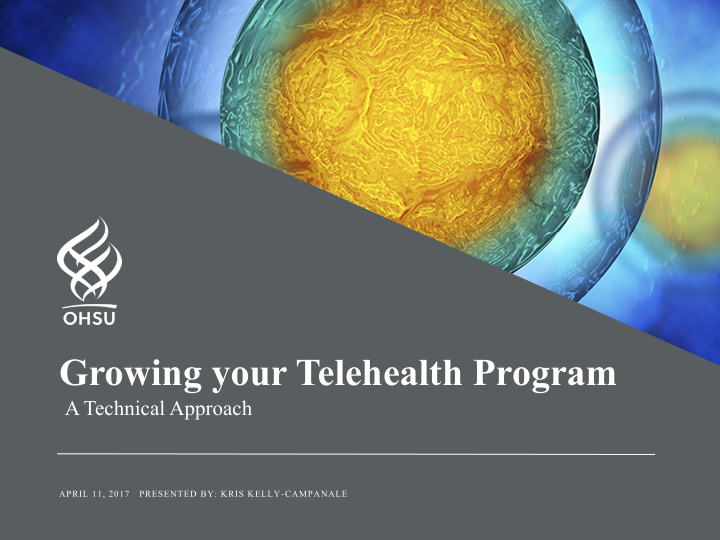



Growing your Telehealth Program A Technical Approach APRIL 11, 2017 PRESENTED BY: KRIS KELLY-CAMPANALE
Disclosures • None 2
Discussion Topics • Introduction • Key fundamentals • Operational considerations • Technology strategy • Wrap-up & questions 3
But first, some assumptions • A basic understanding of telehealth operations • Today’s discussion point of view is from an urban hub site • Advice given is to promote best-practices • Money is an available but finite resource 4
OHSU Hospital Stats: Licensed Beds: 578 2016 Patient Visits: 1,065,800 Employees: 15,642 Students: 3,454 Square Feet of Building Space: 7.8 million Annual Operating Budget: $2.8 billion
OHSU Technology Stats: Unique Networked Devices: 98,498 Wireless Access Points: 2,673 Petabytes of Storage: 8 Email Accounts: 26,600 Data Centers: 2
Acute Care & Ambulatory Telemedicine Network 2007 – PICU pilot 2010 – Network with acute care focus • PICU • Stroke • NICU • Genetics Since – Ambulatory care Multiple service lines 7
OHSU Telehealth Across the Care Continuum Ambulatory Care Remote Monitoring Emergent/Urgent Care The Patient Transitional Care In Hospital Care 8
Key Fundamentals • Be mindful of existing workflows • Design for simple replication • Keep tools easy to scale 9
Existing Workflow Integration • Typically they have precedent • They make or break growth • Key to non-champion buy in • Need to demonstrate value • Can lead to institutional barriers and speedbumps • Overly complicated integration can lead to HIPAA violations • 20-60-20 Rule 10 10
Simple Replication Techniques • Define program’s reach and boundaries • Use pre-defined processes/workflows • Use standardized tools and technology • Know the reimbursement model • Work in consistent EHRs when possible • Define the support plan 11 11
Ensuring Scalability • Workflow automation • Define scope and service • Make sure infrastructure can grow with demand • Design services to be modular • Standardize the user experience 12 12
Operational Considerations • Current evolution of telehealth • Telehealth’s position in the strategic plan • Service line demand and impact 13
Current Evolution of Telehealth • Becoming a component of all clinical departments • Deeper systems integration • Mirroring user-experience with traditional care models • Licensing/credentialing barriers trending down but still present and time consuming. (OR SB 569) • Organizational footprint growth 14 14
Telehealth in the Strategic Plan • Need greater administration backing • Providing technology and support to existing departments • Acting as gatekeepers • Managing expectations 15 15
Predicting Demand and Impact • New deployments have gotten easier but are still complex and time-consuming • Take a critical look at new proposals • Time to reevaluate loss-leader projects • Clinical and financial ROI 16 16
Technology Strategy • The one-app toolbox myth • Maintaining nimble technology • RFI/RFP tactics • Legal, security, and privacy concerns • Operational outreach 17
The One-App Toolbox Myth • Very few groups will benefit • Interoperability is essential • Hub vs. spoke equipment variations • Turn-key vs. integration 18 18
Use of Nimble Technology • Technology should match workflows • Good vs perfect tools • Multi-use technology • Balancing cutting-edge tech with user acceptance • Increases the range of technical capabilities 19 19
RFI/RFP Tactics • Define the organization’s ideal high-level workflow prior to submittal • Go beyond the boilerplate • Drill down on the buzzwords • Conduct deep dives • Be mindful of ecosystem restrictions • Know the licensing, utilization, and growth options • You want to be a vendor’s #1 customer but not customer #0001: how many of these have they done before? 20 20
Legal, Security, and Privacy • People are cautious of what they do not understand • Telehealth is disruptive by nature • Develop an organizational BAA • Early participation in product evaluation • Resources to balance risk with user-experience 21 21
Operational Outreach • Advisory board for stakeholders • Use of metrics for the C-suite • New business assessment workgroup • Involvement with design/construction • The purchasing department is your ally 22 22
Closing Thoughts • Be intra-organizational telehealth evangelists and diplomats • Target the middle 60% • Audit workflows for ease of scalability and replication. Adapt where needed • Chances are that other organizations have been here before. Learn from them. 23
Questions and Comments 24
Thank You Kris Kelly-Campanale kellycam@ohsu.edu
Recommend
More recommend